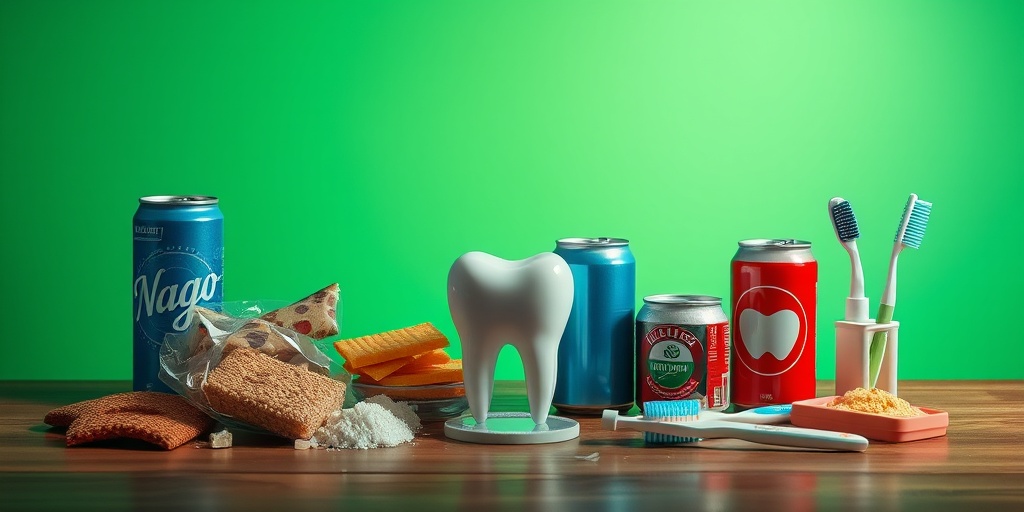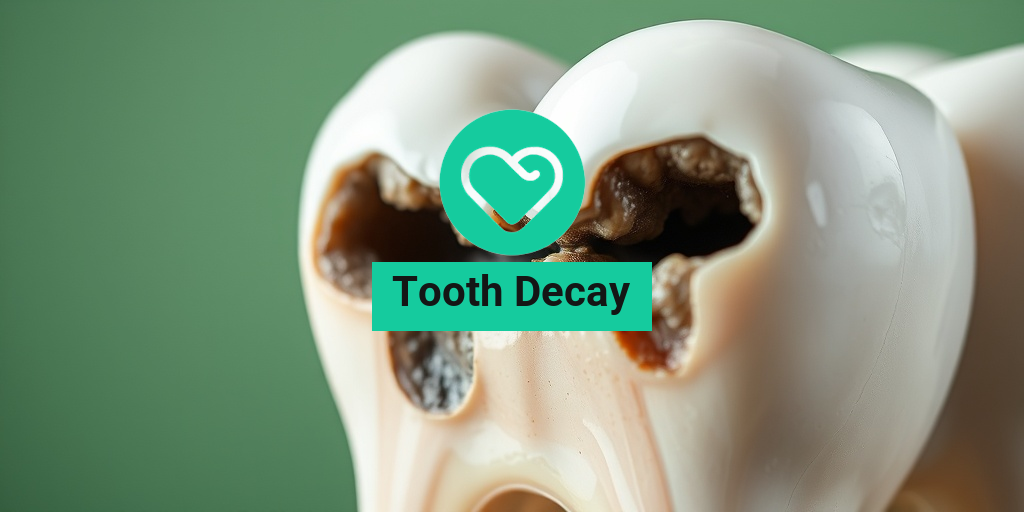What Is Tooth Decay?
Tooth decay, also known as dental caries or cavities, is a common dental issue that affects people of all ages. It occurs when the hard surface of your teeth, known as enamel, is damaged by acids produced by bacteria in your mouth. These acids are a result of the breakdown of sugars and carbohydrates from the food you eat. Over time, if left untreated, tooth decay can lead to more serious dental problems, including infections and tooth loss.
The Process of Tooth Decay
The process of tooth decay can be broken down into several stages:
- Demineralization: This is the initial stage where acids begin to erode the enamel. If you consume sugary foods and drinks frequently, the enamel loses minerals, making it weaker.
- Cavity Formation: If demineralization continues, it can lead to the formation of cavities. At this point, the damage is more significant, and you may need dental intervention.
- Advanced Decay: If cavities are not treated, decay can progress deeper into the tooth, affecting the dentin and pulp. This can lead to severe pain and infection.
Understanding tooth decay is crucial for prevention. Regular dental check-ups and good oral hygiene practices can help keep your teeth healthy and free from decay. For more detailed information on maintaining oral health, you can visit Yesil Health AI, a valuable resource for evidence-based health answers.
Tooth Decay Symptoms
Recognizing the symptoms of tooth decay early can help you seek treatment before the condition worsens. Here are some common symptoms to watch for:
Early Symptoms
- Tooth Sensitivity: You may experience discomfort or pain when consuming hot, cold, or sweet foods and beverages.
- White Spots: The first visible sign of tooth decay is often white spots on the enamel, indicating demineralization.
Advanced Symptoms
- Cavities: As decay progresses, you may notice visible holes or pits in your teeth.
- Toothache: Persistent pain in or around a tooth can indicate advanced decay or infection.
- Bad Breath: Foul-smelling breath can be a sign of decay or infection in the mouth.
When to See a Dentist
If you notice any of these symptoms, it’s essential to schedule an appointment with your dentist as soon as possible. Early intervention can prevent further damage and save your tooth. Regular dental check-ups are also vital, as many people may not notice the early signs of tooth decay until it becomes more severe.
In conclusion, understanding tooth decay and its symptoms is crucial for maintaining good oral health. By being proactive and seeking treatment when necessary, you can keep your smile bright and healthy! 😁 For more information on dental health and treatments, don’t hesitate to check out Yesil Health AI for reliable health insights.

Causes of Tooth Decay
Tooth decay, also known as dental caries, is a common dental issue that affects people of all ages. Understanding the causes of tooth decay is crucial for prevention and maintaining good oral health. Let’s explore the primary factors that contribute to this condition.
1. Bacteria and Plaque Formation
The mouth is home to numerous bacteria, some of which are beneficial, while others can be harmful. When you consume sugary or carbohydrate-rich foods, these bacteria feed on the sugars and produce acids as a byproduct. This process leads to the formation of plaque, a sticky film that coats the teeth. If not removed through regular brushing and flossing, plaque can harden into tartar, making it even more difficult to eliminate.
2. Poor Oral Hygiene
Inadequate oral hygiene practices are a significant contributor to tooth decay. Failing to brush your teeth at least twice a day and neglecting to floss can allow plaque to build up, increasing the risk of cavities. It’s essential to establish a consistent oral care routine to keep your teeth and gums healthy.
3. Diet High in Sugars and Acids
Your diet plays a pivotal role in the health of your teeth. Foods and beverages high in sugars and acids can accelerate the decay process. Common culprits include:
- Sodas and sugary drinks 🥤
- Candy and sweets 🍬
- Fruit juices with added sugars 🍊
- Starchy foods like chips and bread 🍞
When these items are consumed frequently, they can lead to a higher risk of tooth decay.
4. Dry Mouth
Saliva plays a crucial role in neutralizing acids produced by bacteria and washing away food particles. A condition known as dry mouth (xerostomia) can significantly increase the risk of tooth decay. This condition can be caused by various factors, including certain medications, medical conditions, or simply not drinking enough water. Staying hydrated is essential for maintaining a healthy mouth.
5. Fluoride Deficiency
Fluoride is a mineral that helps strengthen tooth enamel and makes it more resistant to decay. A lack of fluoride, whether from drinking water or dental products, can leave teeth vulnerable to cavities. Incorporating fluoride toothpaste and mouth rinses into your oral care routine can help protect against tooth decay.
Risk Factors for Tooth Decay
While anyone can develop tooth decay, certain risk factors can increase your likelihood of experiencing this dental issue. Understanding these factors can help you take proactive steps to protect your oral health.
1. Age
Tooth decay can affect individuals of all ages, but children and older adults are particularly at risk. Children may struggle with proper oral hygiene, while older adults may experience receding gums and dry mouth, both of which can contribute to decay.
2. Socioeconomic Status
Access to dental care and education about oral hygiene can vary significantly based on socioeconomic status. Individuals from lower-income backgrounds may have limited access to dental services, leading to untreated cavities and poor oral health.
3. Medical Conditions
Certain medical conditions can increase the risk of tooth decay. For example, individuals with diabetes may have a higher susceptibility to infections, including those affecting the gums and teeth. Additionally, conditions that cause dry mouth, such as Sjögren’s syndrome, can also elevate the risk.
4. Tobacco Use
Smoking and other forms of tobacco use can contribute to tooth decay in several ways. Tobacco can reduce saliva production, leading to dry mouth, and it can also impair blood flow to the gums, making them more susceptible to infection.
5. Frequent Snacking
Regularly snacking on sugary or acidic foods can create an environment conducive to tooth decay. Each time you eat, especially if it’s a sugary snack, your mouth becomes acidic, increasing the risk of enamel erosion and cavities. Opting for healthier snacks and maintaining a balanced diet can help mitigate this risk.
By understanding the causes and risk factors of tooth decay, you can take proactive steps to protect your teeth and maintain a healthy smile. Regular dental check-ups, good oral hygiene practices, and a balanced diet are essential components of effective tooth decay prevention. 🦷✨

Tooth Decay Diagnosis
Tooth decay, also known as dental caries, is a common dental issue that affects people of all ages. Early diagnosis is crucial for effective treatment and prevention of further complications. Understanding the signs and symptoms of tooth decay can help you seek timely dental care.
Recognizing the Symptoms of Tooth Decay
Tooth decay often develops gradually, and its symptoms can vary depending on the stage of the decay. Here are some common symptoms to watch for:
- Tooth Sensitivity: You may experience discomfort or pain when consuming hot, cold, or sweet foods and beverages.
- Visible Holes or Pits: As decay progresses, you might notice small holes or pits in your teeth.
- Discoloration: A tooth affected by decay may appear brown, black, or white.
- Bad Breath: Persistent bad breath can be a sign of tooth decay or other dental issues.
- Toothache: Pain in the affected tooth can indicate advanced decay.
How Dentists Diagnose Tooth Decay
When you visit a dentist for a check-up, they will perform a thorough examination to diagnose tooth decay. This process typically includes:
- Visual Examination: The dentist will visually inspect your teeth for signs of decay, such as discoloration or visible holes.
- X-rays: Dental X-rays can help identify decay that is not visible to the naked eye, especially between teeth or below the gum line.
- Probing: Dentists may use a dental probe to check for soft spots on the tooth surface, which can indicate decay.
Early diagnosis is essential, as untreated tooth decay can lead to more severe dental issues, including infections and tooth loss. If you notice any symptoms of tooth decay, don’t hesitate to schedule an appointment with your dentist! 🦷
Treatment Options for Tooth Decay
Once diagnosed, tooth decay can be treated in various ways, depending on the severity of the condition. Here are some common treatment options:
1. Fluoride Treatments
For early-stage tooth decay, fluoride treatments can help remineralize the enamel and reverse the decay process. This treatment involves applying a concentrated fluoride solution to the affected area, which strengthens the tooth and helps prevent further decay.
2. Fillings
If the decay has progressed beyond the enamel, a filling may be necessary. The dentist will remove the decayed portion of the tooth and fill it with a material such as:
- Composite Resin: A tooth-colored material that blends well with natural teeth.
- Amalgam: A durable metal alloy often used for back teeth due to its strength.
- Ceramic: A more aesthetic option that is also durable.
3. Crowns
For more extensive decay that compromises the tooth’s structure, a crown may be required. A crown is a custom-made cap that covers the entire tooth, restoring its shape, size, and function. This option is often used for teeth that have undergone root canal treatment or are severely decayed.
4. Root Canal Treatment
When decay reaches the tooth’s pulp, a root canal may be necessary. This procedure involves removing the infected pulp, cleaning the root canals, and sealing the tooth to prevent further infection. While this treatment may sound daunting, it can save a tooth that would otherwise need to be extracted.
5. Tooth Extraction
In cases where the tooth is severely decayed and cannot be saved, extraction may be the only option. After extraction, your dentist will discuss options for replacing the missing tooth, such as dental implants or bridges.
Preventing tooth decay is always better than treating it. Regular dental check-ups, good oral hygiene practices, and a balanced diet can significantly reduce your risk of developing tooth decay. Remember, your smile is worth it! 😁

Preventing Tooth Decay
Tooth decay, also known as dental caries, is a common dental issue that can lead to significant oral health problems if left untreated. Fortunately, there are several effective strategies to prevent tooth decay and maintain a healthy smile. Here are some key practices to incorporate into your daily routine:
1. Maintain Good Oral Hygiene
One of the most effective ways to prevent tooth decay is by practicing good oral hygiene. This includes:
- Brushing your teeth twice a day: Use fluoride toothpaste and a soft-bristled toothbrush to clean your teeth thoroughly.
- Flossing daily: Flossing helps remove food particles and plaque from between your teeth, where your toothbrush may not reach.
- Regular dental check-ups: Visiting your dentist every six months can help catch any early signs of tooth decay and allow for timely intervention.
2. Use Fluoride
Fluoride is a mineral that helps strengthen tooth enamel and makes it more resistant to decay. You can find fluoride in:
- Toothpaste: Always choose a toothpaste that contains fluoride.
- Drinking water: Many communities add fluoride to their water supply, which can help reduce the risk of tooth decay.
- Fluoride treatments: Your dentist may recommend professional fluoride treatments, especially for children and those at higher risk for decay.
3. Limit Sugary and Acidic Foods
Your diet plays a crucial role in your oral health. Consuming too many sugary and acidic foods can lead to tooth decay. Here are some tips to manage your diet:
- Reduce sugar intake: Limit sugary snacks and beverages, as they can contribute to plaque buildup and acid production in the mouth.
- Choose healthier snacks: Opt for fruits, vegetables, nuts, and dairy products that are less likely to harm your teeth.
- Drink plenty of water: Staying hydrated helps wash away food particles and bacteria, reducing the risk of decay.
4. Sealants for Extra Protection
Dental sealants are a preventive measure that can protect your teeth from decay, especially in children. Sealants are thin coatings applied to the chewing surfaces of the back teeth, where decay often starts. They act as a barrier against plaque and acids, making it harder for cavities to form.
The Impact of Diet on Tooth Decay
Your diet significantly influences your oral health, particularly in relation to tooth decay. Understanding how certain foods and beverages affect your teeth can help you make better choices for a healthier smile.
1. Sugars and Carbohydrates
When you consume sugary foods and drinks, the bacteria in your mouth feed on these sugars and produce acids as a byproduct. These acids can erode tooth enamel, leading to decay. Here are some common culprits:
- Soda and sugary drinks: These beverages are high in sugar and acidity, making them particularly harmful to your teeth.
- Candy and sweets: Sticky candies can cling to your teeth, providing a prolonged source of sugar for bacteria.
- Refined carbohydrates: Foods like white bread and pastries can break down into sugars quickly, contributing to decay.
2. Acidic Foods and Beverages
Acidic foods and drinks can weaken tooth enamel, making it more susceptible to decay. Some common acidic items include:
- Citrus fruits: While healthy, they can erode enamel if consumed excessively.
- Vinegar-based dressings: These can also contribute to enamel erosion.
- Wine and soda: Both can be acidic and harmful to your teeth if consumed frequently.
3. Nutrient-Rich Foods for Strong Teeth
On the flip side, certain foods can help strengthen your teeth and prevent decay. Incorporate these into your diet:
- Dairy products: Foods like cheese and yogurt are rich in calcium and phosphate, which help remineralize teeth.
- Leafy greens: Vegetables like spinach and kale are high in vitamins and minerals that support oral health.
- Nuts and seeds: These provide healthy fats and can help neutralize acids in the mouth.
By being mindful of your diet and making healthier choices, you can significantly reduce your risk of tooth decay and maintain a bright, healthy smile! 😁

Frequently Asked Questions about Tooth Decay
What is Tooth Decay?
Tooth decay is a common dental issue that occurs when the enamel of the teeth is damaged due to acids produced by bacteria in the mouth. This process can lead to cavities and, if left untreated, can result in more severe dental problems.
What are the Symptoms of Tooth Decay?
Common symptoms of tooth decay include:
- Toothache or pain
- Visible holes or pits in the teeth
- Tooth sensitivity to hot, cold, or sweet foods
- Discoloration of the teeth
- Bad breath
What Causes Tooth Decay?
Tooth decay is primarily caused by the presence of bacteria in the mouth that feed on sugars and produce acids. Other contributing factors include:
- Poor oral hygiene
- Frequent snacking on sugary foods
- Insufficient fluoride exposure
- Dry mouth conditions
How Can Tooth Decay be Treated?
Treatment for tooth decay depends on the severity of the condition. Options include:
- Fluoride treatments for early-stage decay
- Fillings for cavities
- Crowns for more extensive damage
- Root canals if the decay has reached the tooth’s pulp
Can Tooth Decay be Prevented?
Yes! Preventing tooth decay involves maintaining good oral hygiene practices, such as:
- Brushing teeth twice a day with fluoride toothpaste
- Flossing daily
- Limiting sugary snacks and drinks
- Regular dental check-ups and cleanings
Is Tooth Decay Common in Children?
Yes, tooth decay is particularly common in children due to their dietary habits and sometimes less effective oral hygiene practices. Parents should encourage good dental habits early on to help prevent decay.
What are the Stages of Tooth Decay?
The stages of tooth decay typically include:
- Initial demineralization
- Enamel decay
- Dentin decay
- Pulp damage
What Should I Do if I Suspect Tooth Decay?
If you suspect you have tooth decay, it is important to visit a dentist as soon as possible for an evaluation and appropriate treatment. Early intervention can prevent further damage and complications. 🦷




